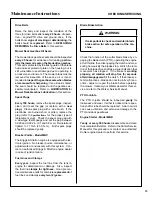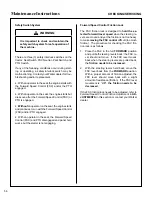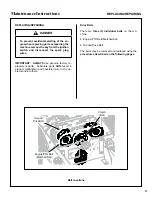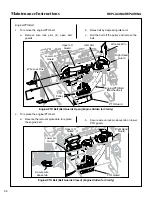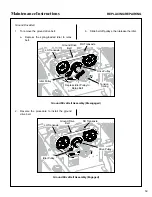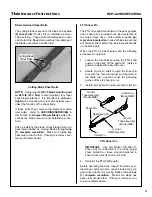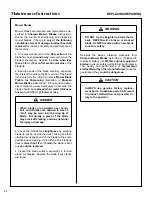
69
Maintenance Instructions
ADJUSTMENTS
Clutch Disengagement/Brake Action
WARNING
It is important to check and maintain blade
brake action for safe operation of the ma-
chine.
The
declutched or disengaged position
of the
blade clutch idler pulley is adjustable and is set to give
belt release
without excessive slack
and to apply
the blade brake. The blade brake is activated by the
brake band connected to the clutch engagement
arm. The brake is designed to stop the blades within
five (5) seconds after disengaging the clutch.
5-3/4 in.
*
(146.05 mm)
Spring
Uncompressed
2-1/8 in.
*
(53.98 mm)
Clutch Engagement
Arm
Knuckle Joint
*NOTE:
These measurements are the presets
used at factory settings to be used for reference.
PTO Clutch Disengaged
Use the following procedures to check and adjust
clutch disengagement and brake action:
Idler Pulley Maximum Travel Adjustment - Step 1
Loosen the brake band adjustment nut allowing stop
arm and stop nut to make contact (refer to
Blade
Brake Band Adjustment
illustration).
1. Adjust the pivot stop bolt to give 1 in. to 1-1/8 in.
(25 mm to 29 mm) pulley travel from “clutch en-
gaged” to “clutch disengaged”.
2. Check and adjust the pulley travel, first engage
the clutch, then measure the distance the pulley
travels as the clutch is disengaged and the stop
arm contacts the stop bolt.
NOTE:
This adjustment will prevent excessive
pulley travel that can cause belts to develop too
much slack, causing possible belt derailment
upon disengagement.
CLUTCH DISENGAGED
CLUTCH ENGAGED
Idler Pulley
Clutch Engagement
Arm
1 in. to 1-1/8 in.
(25 mm to 29 mm)
Clutch Pivot
Stop Arm
Clutch Pivot
Stop Bolt
Clutch Idler Pulley Travel

